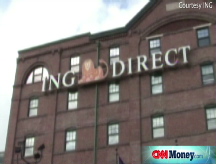Dollar rallies as credit thaws
The greenback was boosted by a thawing credit market and stimulus talk by Fed chair Ben Bernanke.

NEW YORK (CNNMoney.com) -- The dollar surged to its highest level against the euro in nearly a year and a-half Monday as the frozen credit markets showed further signs of thawing and Federal Reserve Chairman Ben Bernanke suggested a second economic stimulus package.
The dollar gained against the euro, which fell to $1.3343 from $1.3379 late Friday. The last time the dollar was higher was June 14, 2007, when the euro was trading at $1.3311.
The dollar also rose against the British pound, which fell to $1.7163 from $1.7202, and gained against the Japanese yen, rising to ¥101.87 from ¥101.59.
The interbank cost of borrowing U.S. dollars fell dramatically Monday as the overnight Libor rate fell to 1.51% from 1.67% on Friday, according to Bloomberg.com. Libor is the daily average of what 16 banks charge other banks to lend money in London and is used to calculate adjustable rate mortgages.
The overnight Libor was nearly even with the 1.5% rate the Federal Reserve charges banks to borrow. Just two weeks ago the overnight Libor had reached as high as 6.88% after the Treasury's $700 billion bailout bill was signed into law on Oct. 3.
The greenback also got a boost from Bernanke, who said Monday that Congress could consider a second stimulus package, although he did not indicate what should be included.
Earlier this year, Congress approved a stimulus plan that sent nearly $100 billion to most tax filers in the form of payments of at least $600, or $1,200 for joint filers. Other tax break for businesses brought the cost of the entire package to close to $170 billion.
Global crisis: A decision Sunday by the Netherlands to inject $13.4 billion into Dutch banking giant ING (ING) lifted the euro briefly, but concerns about the non-U.S. economy continued to weigh on the market.
The Dutch bailout is the latest non-U.S. government action aimed at restoringconfidence to the banking sector as the financial crisis expands. South Korea also announced a plan over the weekend to guarantee up to $100 billion in foreign currency loans and inject $30 billion into its banking sector.
"One of the things that everyone agrees is that the global economy is slowing down," said Antonio Sousa, chief strategist with DailyFX.com. "The world economy (is) slowing down even faster than the U.S."
As trouble began brewing in the U.S. subprime mortgage market, the Federal Reserve was the first central bank to respond by cutting its key interbank lending rate.
With the economic crisis in full swing, cheaper - and thus more easily obtainable - currencies such as the dollar and the yen are in a better position to recover later on down the road, said Sousa.
Investors are shifting their investments from export-dependent currencies, such as the Australian and New Zealand dollars, to the U.S. dollar and yen, which are cheaper than the euro, he explained.
Treasury boost. Investors are also seeking the safety of U.S. government bonds, which offer a lower but guaranteed return over more risky equities. Investors typically shift assets into Treasurys during times of economic turmoil.
Long-term bonds rallied Monday, with the benchmark 10-year note rising 9/32 to 100-27/32 as its corresponding yield slipped to 3.89%.
The rally in Treasurys was also giving a lift to the dollar because foreign entitites that want to shift assets to U.S. bonds need to first convert their currencies, driving up demand for dollars, said John Kicklighter, currency strategist with Forex Capital Markets.
"Everyone's trying to get the best risk-free market, and that's Treasurys," said Kicklighter. "They're looking for very short-term secure assets."
Oil: Commodities such as oil are traded in dollars, so a decline in the value of oil makes the dollars themselves a much more attractive investment.
Crude oil futures have declined some 50% from a record high of $147.27 a barrel in mid-July, which helped bring gasoline prices to a national average of $2.92 a gallon on Monday, according to motorist group AAA.
The cut in oil prices also "should probably alleviate some pressure on the U.S. economy," said Sousa. The U.S. is the world's largest oil consumer. That will likely help the dollar in the long-term, he added. ![]()


